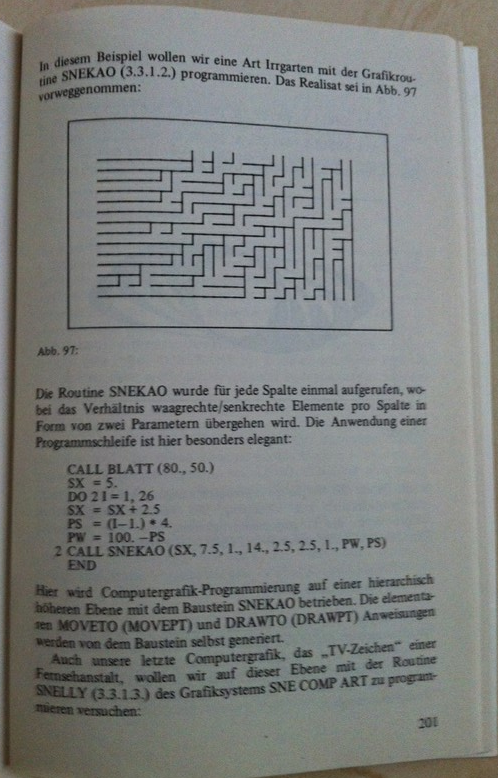Dietrich M. Scheringer did all the coding to bring SNE ART of 1976 back to life in Processing (2013). Also he developed a universal filling algorithm (see below).
SNE (COMP) ART is published in detail in the book “Computergrafik, Ein Lehr- und Lernbuch” by Lothar Limbeck and Reiner Schneeberger, Ernst Reinhardt Verlag, München, 1979. The concept of the system, that might be indeed the first art machine based on parameters, is published in part 3 of the book (page 114-202). All paramerters for the routines including the generators for random numbers are outlined. By these random generators SNERAD, SNEZUF, SNERGA, SNERIN the artist who uses SNE ART is able to determine the way randomization is used. To find d balance between determination and chaos is one of the triggering aspects in the art that comes out by using SNE ART.
FORTRAN, used in the late 70s as the main programming language for scientific and technical purposes offers a very special style in doing things, rather different to Processing as we see it in the year 2013. Indeed FORTRAN makes some things much more easy. You can combine routines and place them in a sequence in no time. Using SNE ART became a way to teach using FORTRAN. By doing it the SNE ART way it was like expanding the universe of generative computer art. Each student in the Department of Art Education at the University of Munich made it. No one failed. Some became rather good programmers in using SNE ART routines even for filming purposes. It is like one driving a car easily and then he is asking: how does the car work? Can I change a seat? Can I modify the engine? Oh, I see a lamp broken, I will change it by myself!
Dietrich M. Scheringer took the goal to bring the SNE ART routines back to life in the way of 1976 to Processing. He has all the original FORTRAN code in hand and knows FORTRAN very well. To keep the code in Processing short and usable for everyone the routines got “capsuled”. So its very easy to use one sketch, but …. There is a big but to add. In FORTRAN you can call a routine in repetitive ways very easy so a sheet of paper (or a screen) can be filled step by step. You can add art made by different routines on one sheet and the coding complexity is not increasing. The artist still sees whats going on. Noone will cry and say: it is too much math for me! This means you can easily build up rows and areas on a single sheet and for a film you can perform moving art drawings based on ‘plotted lines’.
Let me show it by using the example of page 201 in the book:

Just a brief explanation: SNEKAO is called in a loop 26 times drawing one column on each call. SX starts at 5 and increases by 2.5. PW and PS are the percentage of horizontal and vertical boxes (lines). PW moves from 100 down and PS moves up from 0 to 100. The size of the sheet of paper is 80 to 50 units (=cm).
To make a scetch in Processing doing this way you need to know more about programming in Processing. Why not? You can use the sketches of Dietrich M. Scheringer and expand your universe of art the way of the 70s or the way of the 21st century. It is on you only!
Universal filling algorithm
To have ‘a bridge’ from old plotter driven SNE ART (1976) to screeen driven Computer Minimal Art (1985) I asked Dietrich M. Scheringer to work out a way to fill an area that has borders around (by using Processing stable version 1.5.1).
![filling[1]](https://recodeart.wordpress.com/wp-content/uploads/2013/04/filling1.png?w=584)
I asked the Processing community how to do it. I got several replies but none had a solution that was exactly what I was looking for. Indeed I was told that none has made it until now as its very difficult and a stack overflow could result. You find the code of Dietrich on the private page ‘Filling an area for computer minimal art‘.
Dietrich in his e-mail of March, 26, 2013: “In einer der Antworten auf Deine Anfrage bzgl. des Füllens von geschlossenen Bereichen hatte ja ein Programmierer geantwortet, dass das in Processing nicht ganz so einfach sei. Aber ich denke, das kann ich sagen, wir haben die entsprechende Technik nun zur Verfügung, das Problem ist gelöst, egal, ob ein Bereich durch gerade Linien oder gekrümmte Linien (z.B. snelin) umrandet wird oder ob es sich um einen wilden Pixelrand handelt.”
